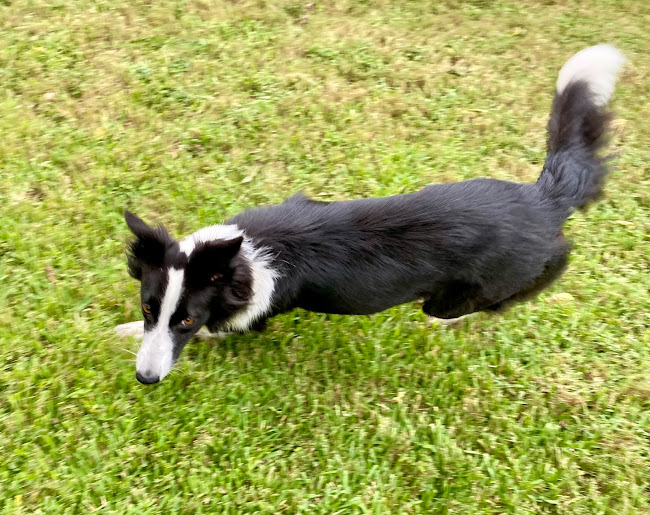Meggie took her No Puppy Pledge this week. Though she has a heavy load of heartworms, her veterinary surgeon explained that otherwise healthy bitches are better able to handle the stress of surgery before heartworm treatment than after. The dead heartworms in the system are a bigger threat than just going ahead and getting the spay surgery out of the way earlier before heartworm treatment begins.
So Meggie underwent an ovariohysterectomy. She will definitively never again have puppies, which is the entire point. Gratefully she is approximately a two-year-old adult dog, so hopefully she will retain much of the long-term physical benefits of leaving a female dog with her ovaries through adulthood.
If Meggie were going to be living with me for her entire life, I would have opted to either keep her intact and never allow her the opportunity to become pregnant, or I would have chosen an ovary-sparing hysterectomy. Retaining the ovaries significantly reduces the risk of developing certain diseases, potentially leading to a longer life for the dog. Rescues, including BCSave, have to ere on the side of caution to prevent human carelessness and make the best use of limited resources, so in Meggie's case a traditional ovariohysterectomy makes the best of her situation.
Meggie came into rescue with a singleton puppy in tow, so her mammaries and the blood vessels inside and around them are enlarged. This caused a fair amount of bleeding under the skin around the spay surgery incision site so Meggie has significant bruising. For the first 48 hours Meggie wore a pressure bandage around her belly to prevent additional bleeding.
Meggie has graduated into wearing a soft comfort cone and a belly-guard body suit to prevent her from licking the incision site. As of day three the suit and cone have done an adequate job of preventing her from messing with the wound site. I have had to rotate to using a longer hard plastic cone at night while I can't be as vigilant.
After testing three different cones and two bodysuits, the best post-surgery suit is this Belly Guard brand recovery onesie, and the most comfortable cone is this All Four Paws brand comfy cone. The Belly Guard onesie is lightweight and breathable, and the best feature is convenient potty breaks with snaps in the front to secure the flap while Meggie does her business. I don't have to remove the suit over her head and it stays clean and dry while she's walking around outside. The comfy cone prevents her from licking but is soft, smaller, and fastens with velcro, keeping her more comfortable.
The veterinary surgeon placed absorbable sutures under the skin and glued the skin closed. It's done this way so clients don't have to return for another vet visit for suture removal. She has to wear the lampshade for 7 to 10 days, and there is significant bruising because of the bleeding, but overall she is doing well.
I am incredibly grateful to Dr. Jenny Elkins at Texas Foundation for Animal Care (TFAC), a donation-based satellite clinic that provides low-cost heartworm treatment and neuter surgery. Hundreds of dogs in Texas are euthanized daily due to heartworm disease, which spreads through mosquitoes and is contracted year-round due to our warm climate. While it's affordable to prevent infection with monthly oral or six-month injections, the costly treatment of infected dogs often prevents their adoption or leads to surrender for euthanasia.
Pearls:
- Meggie took the No Puppy Pledge, opting for an ovariohysterectomy to prevent future pregnancies despite her heartworm condition.
- Spaying before heartworm treatment was chosen, as the dead and dying heartworms after treatment pose a bigger threat.
- The ideal post-surgery suit for Meggie is the Belly Guard recovery onesie, which is lightweight, breathable, and allows easy potty breaks with front snaps. The Comfy Cone is good too, as it's soft, secures with velcro, and ensures comfort while preventing licking.
- Although a traditional spay was performed due to rescue resource constraints, ideally an ovary-sparing hysterectomy or keeping her intact (preventing pregnancy with management) would have been considered.
- Despite bruising and post-surgery precautions, Meggie is recovering well, thanks to the efforts of Dr. Jenny Elkins and her staff at TFAC, a clinic addressing the heartworm crisis in Texas.
















